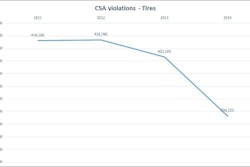CEO Study: What three things would you focus your business on to differentiate yourself in the marketplace?”
The “Amazon Effect” has led to considerable growth and evolution in consumer expectations and behaviors over the past five years. Remembering the first law of sales (that purchasers are still humans—even on the job), it is logical to assume that personal experience will lead ‘industrial expectations.’
The last downturn continues to be brutal in its severity. How did you like this year’s first quarter? It is also highly unusual over the last 60 years in the heavy-duty industry and probably a tail event in probability terms. If distributors and suppliers are letting capital and strategy decisions be influenced by an extreme market contraction that is not likely to reoccur, they are probably moving too conservatively and too slowly.
But growing through this flat spot takes vision and execution. Companies have neither the time nor resources for a dartboard approach to growth. For heavy-duty distributors inclined to go the niche, technical sales (value-added services) route, national capabilities through a group affiliation, a highly trained and knowledgeable sales force (with provision for continuous education), and strong bench or service bay capabilities are a must.
Mid-size companies—those just big enough to have lost some nimbleness and added layers of support costs but too small to be generate the cash necessary to sufficiently invest in the business—are at risk.
Companies need to plan how to add sufficient scale, boost their technical bonafides, or exit the business.
Survey Says …
Recently BB&T Capital Markets and Fortna (a professional services firm helping companies with complex distribution operations) asked leading industrial suppliers: “If you were the CEO of one of the top industrial distributors, what three things would you focus your business on to differentiate yourself in the marketplace?”
The answers are maybe even more relevant to heavy-duty service and parts distribution than the generally more sophisticated industrial specialist distributors who were the subject of the study. Some included:
- Distributors need to get the most out of their capital by putting it to work for them. Distribution is no longer a lifestyle business; it is a business that requires significant capital re-investment to keep up or get ahead. Firms that focus on capital preservation will likely lose market position over time versus those that focus on capital appreciation.
- Distributors should be aware of and consider how best to take advantage of “convergence.” Historically, companies have had geographic identities, product specialties, an emphasis on certain paths to the market or a service model, etc. In many respects, those differences defined the company. Slavish commitments to these identities could become an issue. At the end of the day, what the company has is its customers, and its customers want procurement to be as easy as possible.
- Customers want a broader offering across a wider regional swath ordered and delivered efficiently through several channels. Over time, companies have taken advantage of this by adding products/services to their core, expanding geographically, investing in channel strategies, etc. These changes are driving firms toward a common model, one that is better able to give a consolidated customer base what it wants.
- The risk of not investing in new channels is that the customer will go elsewhere for the convenience “one-stop shopping.” The return on such investments, however, includes a source of growth that is independent of end market demand (new channels, such as vending and e-commerce, tend to grow faster than the market as a whole; spreading new products across the existing customer base captures more of the customer spend; geographic expansion can bring new customers and market share gains).
- Distributors will need to embrace technology. IT gets a bad rap going back to the 1990s, when even mighty Grainger’s ERP conversion sent it back to taking orders on scratchpads. The fact is, since that time distribution-specific packages have been developed for the heavy-duty parts market and there are great examples of successful technology roll-outs. It is now simply too costly and too inefficient to have multiple platforms. Customers are becoming too technologically savvy for you not to have an interactive, customer-facing on-line option.
- Capital and profitability is simply too dear not to have strong, system-wide visibility of inventory and some control (within limits) of pricing in the field. Any long-term strategy to grow and become more logistically efficient has to have at its core a robust technological base.
I have spoken recently on the start of convergence to what many refer to as the “omni-channel” approach that includes a direct, wholesale, and retail channel that enable “one-stop shopping.” Retailers have taken the lead in this arena, and I believe the heavy-duty sector can benefit by following similar tactics.
The average fleet buyers and maintenance guys have grown accustomed to being able to compare prices online, order any item at any time using the most convenient means possible, and expect that the order will be delivered without errors at the time it is promised. They are taking that expectation to work with them, and for distributors that means more savvy and demanding customers.
Distribution companies that embrace a strategy which includes investment to grow the business, understanding the business and supply chain implications of channel convergence, and use of technology as an enabler, will seize competitive advantage now and in the future.
What key trends/challenges will shape the distribution landscape?
Short-Term (one to two years): Firms need to make sure they have gotten over the residual shock of the Great Recession. Best-in-class companies have:
- Restored inventory to ensure availability, acknowledging this as their customers’ top concern.
- Invested in sales to support growth.
- Invested in working capital is imperative for the health of the business.
Even if business conditions slow down again, best-in-class distributors continue to be able to generate profits and cash flow and are using those cycles to strengthen the business.
Medium-Term (two to five years): A robust, targeted, and effectively executed capital plan is necessary. Distributors moving toward the broad-line, multi-channel route must have robust back-end and front-end (customer facing) IT systems, efficient logistics, and expanding geographic and product offerings. Best-in-class distributors are ahead in developing these models, and the market is still so fragmented that others could still arise.
Long-Term (beyond five years): Companies need to declare their intentions, especially to key employees: Service-intensive; commodity or tech-heavy; national, regional or local focus; broad line or technical-oriented, niche player. Even for truck dealers, heavy-duty parts and service is consolidating at an accelerating rate and starting to shake out into winners and losers.
The study authors included a nod to what I have believed to be critical in this phase of growth in the heavy-duty market: That it is important to maintain commitment to a long-term strategy—even as you implement short-term changes.
They report that they often encounter distributors who have great strategic vision, but without commitment to the vision they sacrifice the benefits with short-term responses to the challenges before them.
It takes an incredible commitment to build and sustain a competitive advantage. Companies need strong leadership that develops the vision and the commitment to execute on that vision over the long-term. Anything short of that is a losing proposition.
Bill Wade is a partner at Wade & Partners and a heavy-duty aftermarket veteran. He is the author of Aftermarket Innovations. He can be reached at [email protected].










